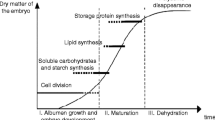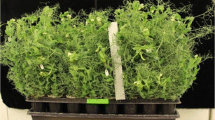Abstract
A bottleneck for genetic research and breeding of crop plants is the time taken to producing large pure line segregating populations so called recombinant inbred lines (RILs). One way to overcome this problem is through use of the single-seed-decent (SSD) process under in vitro conditions. A number of factors that may affect in vitro SSD approach of wheat including temperature, light duration and intensity, salt strength and carbohydrate concentration were investigated in this study. Under the in vitro conditions, 45 days per generation was achieved for an early flowering wheat genotype Emu Rock, allowing eight generations per annum; 58 days per generation was achieved for mid flowering genotypes, allowing six generations per annum. The results showed that a variation of growth environment before and after three-leaf stage allowed in vitro seed-set with a relatively short generation time. Specifically, the plantlets were first grown under 22 °C with a light intensity of 145 μmol m−2 s −1 (16 h d−1) for 20 days (around three-leaf stage), and then moved to an environment of 28 °C and 500 μmol m−2 s−1 (20 h d−1) light. The culture medium was 1/2 strength Murashige and Skoog (MS) with modification of adding ten times of extra KH2PO4 and 4% sucrose. The fully in vitro protocol resulted in 100% flowering rate and average seed set rate of 91.5% in Emu Rock and Zippy. It can be further fine-tuned to suit different genotypes and it has a potential for factory scale mass-production of RILs for genetic studies and practical breeding programs.

Similar content being viewed by others
References
Amanullah Khan MW (2010) Interactive effects of potassium and phosphorus on phenology and grain yield of sunflower in Northwest Pakistan. Pedosphere 20:674–680
Araki T, Komeda Y (1993) Flowering in darkness in Arabidopsis thaliana. Plant J 4:801–811
Blumel M, Dally N, Jung C (2015) Flowering time regulation in crops-what did we learn from Arabidopsis? Curr Opin Biotech 32:121–129
Borras-Gelonch G, Rebetzke G, Richards R, Romagosa I (2012) Genetic control of duration of pre-anthesis phases in wheat (Triticum aestivum L.) and relationships to leaf appearance, tillering, and dry matter accumulation. J Exp Bot 63:69–89
Bos HJ, Neuteboom JH (1998) Morphological analysis of leaf and tiller number dynamics of Wheat (Triticum aestivum L.): responses to temperature and light intensity. Ann Bot 81:131–139
Cha-um S, Samphumphuang T, Kirdmanee C (2012) In vitro flowering of indica rice (Oryza sativa L. spp. indica). In Vitro Cell Dev Biol Plant 48:259–264
Croser JS, Pazos-navarro M, Bennett RG, Tschirren S, Edwards K, Erskine W, Creasy R, Ribalta FM (2016) Time to flowering of temperate pulses in vivo and eneration turnover in vivo–in vitro of narrow-leaf lupin accelerated by low red to far-red ratio and high intensity in the far-red region. Plant Cell Tissue Organ Cult. doi:10.1007/s11240-016-1092-4
El-Hennawy MA, Abdalla AF, Shafey SA, Al-Ashkar IM (2011) Production of doubled haploid wheat lines (Triticum aestivum L.) using anther culture technique. Ann Agric Sci 56:63–72
Humphreys DG, Knox Ron E (2015) Doubled haploid breeding in cereals. In: Al-Khayri JM, Jain SM, Johnson DV (eds) Advances in plant breeding strategies: breeding, biotechnology and molecular tools. Springer International Publishing, Switzerland, pp 241–290
Kachonpadungkitti Y, Romchatngoen S, Hasegawa K, Hisajima S (2001) Efficient flower induction from cultured buckwheat (Fagopyrum esculentum L.) node segments in vitro. Plant Growth Regul 35:37–45
Liu D, Liu W, Zhu D, Jin H, Guo L, Zuo Z, Liu L (2010) Effect of phosphate fertilizer supply on growth, yield and nutrient absorption of Chrysanthemum morifolium (Ramat.). S Chin J Agr Sci 123:1575–1580
Liu Y, Yu L, Tong J, Ding J, Wang R, Lu Y, Xiao L (2013) Tiller number is altered in the ascorbic acid-deficient rice suppressed for l-galactono-1,4-lactone dehydrogenase. J Plant Physiol 170:389–396
Liu H, Zwer P, Wang H, Liu C, Lu Z, Wang Y, Yan G (2016) A fast generation cycling system for oat and triticale breeding. Plant Breed 135:574–579 doi:10.1111/pbr.12408
Mobini SH, Warkentin TD (2016) A simple and efficient method of in vivo rapid generation technology in pea (Pisum sativum L.). In Vitro Cell Dev Biol Plant. doi:10.1007/s11627-016-9772-7
Mobini SH, Lulsdorf M, Warkentin TD, Vandenberg A (2015) Plant growth regulators improve in vitro flowering and rapid generation advancement in lentil and faba bean. In Vitro Cell Dev Biol Plant 51:71–79
Murashige T, Skoog F (1962) A revised medium for rapid growth and bioassays with tobacco tissue cultures. Physiol Plant 15:473–497
Nelson MN, Berger JD, Erskine W (2010) Flowering time control in annual legumes: prospects in a changing global climate. CAB Rev Perspect Agric Vet Sci Nutr Nat Res 5:49–62
Ochatt SJ, Sangwan RS (2010) In vitro flowering and seed set: acceleration of generation cycles. In: Davey MR, Anthony P (eds) Plant cell culture: essential methods. Wiley, Chichester, pp 97–110
Ochatt SJ, Sangwan RS, Marget P, Ndong YA, Rancillac M, Perney P, Röbbelen G (2002) New approaches towards the shortening of generation cycles for faster breeding of protein legumes. Plant Breed 121:436–440
Petraglia A, Tomaselli M, Mondoni A, Brancaleoni L, Carbognani M (2014) Effects of nitrogen and phosphorus supply on growth and flowering phenology of the snowbed forb Gnaphalium supinum L. Flora-Morph Distr Funct Ecol Plants 209:271–278
Ribalta FM, Croser JS, Erskine W, Finnegan PM, Lulsdorf MM, Ochatt SJ (2014) Antigibberellin-induced reduction of internode length favors in vitro flowering and seed-set in different pea genotypes. Biol Plant 58:39–46
Ribalta FM, Pazosnavarro M, Nelson K, Edwards K, Ross JJ, Bennett RG, Munday CM, Erskine W, Ochatt SJ, Croser J (2016) Precocious floral initiation and identification of exact timing of embryo physiological maturity facilitate germination of immature seeds to truncate the lifecycle of pea. Plant Growth Regul. doi:10.1007/s10725-016-0211-x
Smeekens S, Ma JK, Hanson J, Rolland F (2010) Sugar signals and molecular networks controlling plant growth. Curr Opin Plant Biol 13:274–279
Song Y, Gao Z, Luan W (2012) Interaction between temperature and photoperiod in regulation of flowering time in rice. Sci China Life Sci 55:241–249
Song Y, Ito S, Imaizumi T (2013) Flowering time regulation: photoperiod and temperature-sensing in leaves. Trends Plant Sci 18:575–583
Sparkes DL, Holme SJ, Gaju O (2006) Does light quality initiate tiller death in wheat? Eur J Agronomy 24: 212–217
Susan IG (2005) Control of plant development and gene expression by sugar signaling. Curr Opin Plant Biol 8:93–102
Vu NH, Anh PH, Nhut DT (2006) The role of sucrose and different cytokinins in the in vitro floral morphogenesis of rose (hybrid tea) cv. “First prize”. Plant Cell Tissue Organ Cult 87:315–320
Yao Y, Zhang P, Wang H, Lu Z, Liu C, Liu H, Yan G (2016) How to advance up to seven generations of canola (Brassica napus L.) per annum for the production of pure line populations? Euphytica 209:113–119
Yermishina NM, Kremenevskaja EM, Gukasian ON (2004) Assessment of the combining ability of triticale and secalotriticum with respect to in-vitro androgenesis characteristics. Russ J Genet 40:282–287
Zeng S, Liang S, Zhang Y, Wu K, Teixeira DS, Duan J (2013) In vitro flowering red miniature rose. Biol Plant 57:401–409
Zhang Q, Tu D (1986) Flowered and fruited of the wheat in tube. J Hen Norm Univ 49:105–107
Zheng Z, Wang H, Chen G, Yan G, Liu C (2013) A procedure allowing up to eight generations of wheat and nine generations of barley per annum. Euphytica 191:311–316
Ziv M, Naor V (2006) Flowering of geophytes in vitro. Propag Ornam Plants 6:3–16
Acknowledgements
Financial supports from the Australian Council of Grain Grower Organisations (COGGO) Research Fund 2014–2015, National Natural Science Foundation of China (41373118), and Guangzhou Education Bureau Innovation Team Project (No.13C02) are appreciated. Y. Yao would like to thank China Scholarship Council (CSC) for her visiting scholarship at The University of Western Australia.
Author contributions
YY, HL, ZL, GY conducted experimental design, data analysis and manuscript writing. PZ was involved in strategic experimental input. YY and HL conducted the in vitro experiments.
Author information
Authors and Affiliations
Corresponding authors
Ethics declarations
Conflict of interest
The authors declare that they have no conflict of interest.
Rights and permissions
About this article
Cite this article
Yao, Y., Zhang, P., Liu, H. et al. A fully in vitro protocol towards large scale production of recombinant inbred lines in wheat (Triticum aestivum L.). Plant Cell Tiss Organ Cult 128, 655–661 (2017). https://doi.org/10.1007/s11240-016-1145-8
Received:
Accepted:
Published:
Issue Date:
DOI: https://doi.org/10.1007/s11240-016-1145-8




